Long-term monitoring of health inequalities: March 2017
Update of long-term indicators of health inequalities, such as healthy birth weight and alcohol-related hospital admissions.
This document is part of a collection
Inequalities in morbidity and mortality indicators
The relative index of inequality ( RII) indicates the extent to which health outcomes are worse in the most deprived areas compared to the average throughout Scotland. While comparisons of RII between indicators are possible, they should be made with some caution, in particular where absolute values are significantly higher or lower in the compared indicators or where the measurement scale differs (for example, relative inequalities in Mental Wellbeing scores, which are based on responses to survey questions, compared to relative inequalities in an age-standardised mortality rate).
The following charts group indicators in this report into broadly comparable categories: the first shows hospital admissions and incidence of conditions for people belonging to the under 75 age group; while the second shows mortality rates in the 45-74 age group for three causes of death.
Although relative inequalities in alcohol-related hospital admissions have declined over the long term and heart attack hospital admissions inequalities have increased in the years since 2008, relative inequalities have remained highest in the alcohol-related indicators throughout the period covered by this report. Inequalities in cancer incidence have been more stable in relative terms.
Figure 4.1: Relative Index of Inequality (RII) Selected morbidity indicators (ages <75 years) Scotland 1997-2015
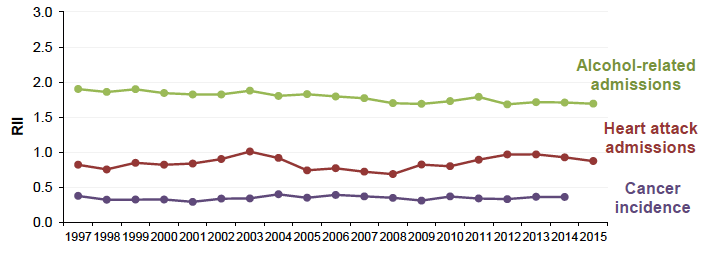
Relative inequalities in CHD mortality among adults aged 45-74 have increased over the long term. Alcohol-related deaths relative inequalities have shown more year to year fluctuation over the same period. However, the RII for alcohol-deaths in 2015 (1.88) is the same as at the start of time series.
Although RII in cancer mortality has increased slightly over the longer term, inequalities remain widest in alcohol-related deaths and coronary heart disease deaths.
Figure 4.2: Relative Index of Inequality (RII) Mortality indicators (ages 45-74 years) Scotland 1997-2015
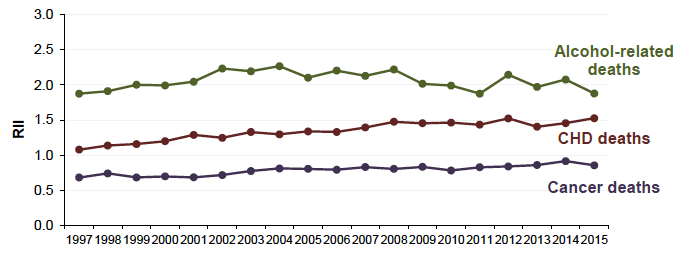
Coronary Heart Disease - first ever hospital admission for heart attack aged under 75 years
Trends in heart attack hospital admissions
In 2015, around 4,500 new cases of heart attack (for those aged under 75 years) were recorded in Scottish hospitals.
The rate of admissions is currently 36% lower than in 1997. However, following increases between 2007 and 2012 the rate of admissions is higher than the low point seen in 2007.
Inequalities in hospital heart attack hospital admissions, 2015
The latest admission rate in Scotland's most deprived areas is 2.3 times greater than that of the least deprived (139.9 cases per 100,000 compared to 59.5 per 100,000).
Figure 5.1: Hospital admissions for heart attack among those aged <75y by Income-Employment Index, Scotland 2015 (European Age-Standardised Rates per 100,000)
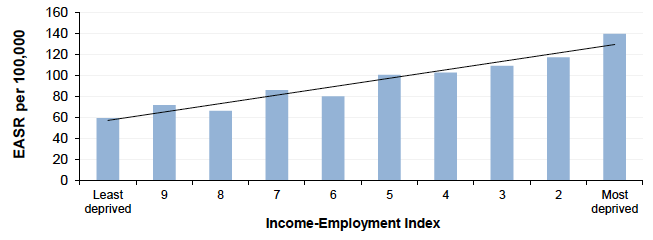
Trends in relative inequalities
Relative inequality levels for heart attack hospital admissions have fluctuated over time. The RII for 2015 (0.87) is currently similar to that at the start of the time series (0.82)
Figure 5.2: Relative Index of Inequality (RII): Hospital admissions for heart attack <75y Scotland 1997-2015
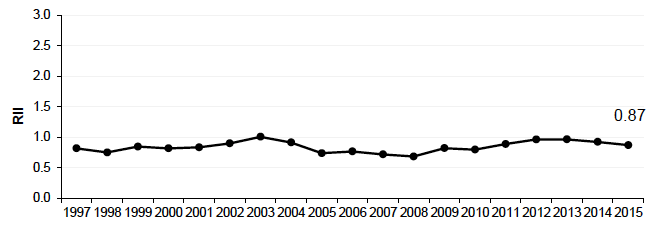
Heart attack hospital admission rates (aged < 75) have generally been approximately 2-3 times higher in the most deprived areas compared to the least deprived areas. In 2015, rates are 2.3 times higher in the most deprived areas than in the least deprived.
Trends in absolute inequalities
Absolute inequalities have also fluctuated. Following consecutive reductions between 2003 and 2007, the gap widened until 2012 before narrowing again in the three years since. The gap remains larger than at the narrowest point reached in 2007.
Figure 5.3: Absolute Gap: Hospital admissions for heart attack <75y Scotland 1997-2015 (European Age-Standardised Rates per 100,000)
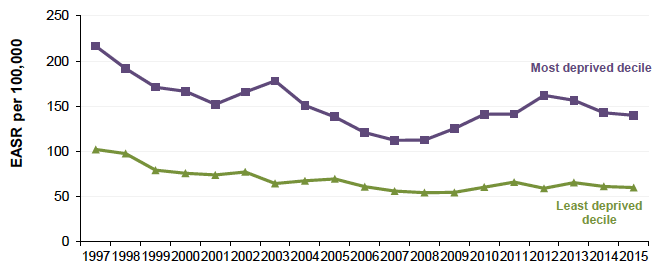
In 2015, the heart attack admission rate in the most deprived areas was 139.9 per 100,000, compared to a rate of 59.5 per 100,000 in the least deprived areas (a gap of 80.3 per 100,000).
The gap was largest in 1997, when the admissions rate was 216.5 per 100,000 and 101.9 per 100,000 in the most and least deprived areas respectively (a gap of 114.6 per 100,000).
Table 5.1: Trends in heart attack hospital admissions (aged <75), 1997-2015
| Total admissions | Population | Rate per 100,000 ( EASR) | |
|---|---|---|---|
| 1997 | 5,764 | 4,740,269 | 145.1 |
| 1998 | 5,676 | 4,729,975 | 141.5 |
| 1999 | 5,101 | 4,721,298 | 126.6 |
| 2000 | 4,812 | 4,708,667 | 118.4 |
| 2001 | 4,776 | 4,703,661 | 116.9 |
| 2002 | 4,833 | 4,701,958 | 116.6 |
| 2003 | 4,569 | 4,702,431 | 109.0 |
| 2004 | 4,413 | 4,714,233 | 103.9 |
| 2005 | 4,047 | 4,735,320 | 94.2 |
| 2006 | 3,750 | 4,752,425 | 86.4 |
| 2007 | 3,549 | 4,783,452 | 80.4 |
| 2008 | 3,655 | 4,811,453 | 81.7 |
| 2009 | 3,851 | 4,835,007 | 84.9 |
| 2010 | 4,377 | 4,858,058 | 95.4 |
| 2011 | 4,537 | 4,888,316 | 97.7 |
| 2012 | 4,747 | 4,895,114 | 100.8 |
| 2013 | 4,697 | 4,903,074 | 98.8 |
| 2014 | 4,498 | 4,914,362 | 93.3 |
| 2015 | 4,513 | 4,935,283 | 92.7 |
Coronary Heart Disease ( CHD) - deaths aged 45-74 years
Trends in CHD deaths
Since 1997, there has been a considerable decrease in CHD mortality amongst the population aged 45-74 years. The death rate has fallen by 66% to 133.7 per 100,000. However, CHD remains one of Scotland's biggest causes of premature mortality, with around 2,500 deaths occurring in this age group in 2015.
Inequalities in CHD deaths, 2015
In 2015, the CHD mortality rate was 5.2 times greater in Scotland's most deprived areas compared to the least deprived (258.5 compared to 49.9 deaths per 100,000 population).
Figure 6.1: CHD mortality amongst those aged 45-74y by Income-Employment Index, Scotland 2015 (European Age-Standardised Rates per 100,000)
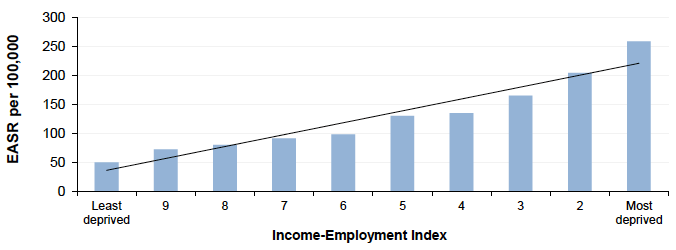
Trends in relative inequalities
Relative inequalities in CHD mortality have grown over the longer term. In particular, there was a steady growth between 1997 and 2008. Since 2008, relative inequalities have fluctuated in the range of 1.40-1.52.
Figure 6.2: Relative Index of Inequality (RII): CHD mortality 45-74y Scotland 1997-2015
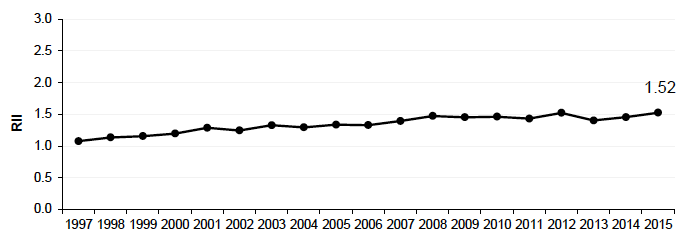
Since 1997, CHD mortality rates have typically been 3-4 times higher in the most deprived areas compared to the least deprived areas. In both 2014 and 2015, rates were 5 times higher in deprived areas.
Trends in absolute inequalities
Absolute inequality has reduced over the longer term from a high in 1998. Despite an increase in the gap in the two most recent years, the current gap is 47% lower than in 1998.
Figure 6.3: Absolute Gap: CHD mortality 45-74 years, Scotland 1997-2015 (European Age-Standardised Rates per 100,000)
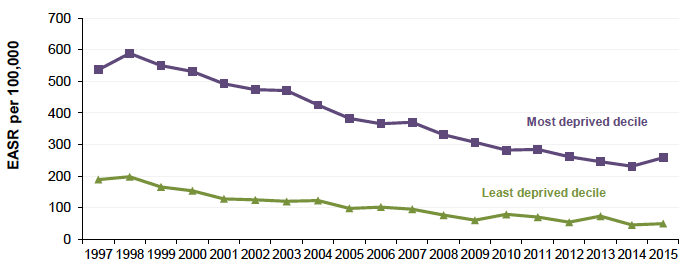
Table 6.1: Trends in coronary heart disease deaths (aged 45-74), 1997-2013
| Number of deaths | Target population size | Rate per 100,000 ( EASR) | |
|---|---|---|---|
| 1997 | 5,887 | 1,635,590 | 372.5 |
| 1998 | 5,675 | 1,646,711 | 357.9 |
| 1999 | 5,389 | 1,658,124 | 338.9 |
| 2000 | 4,858 | 1,670,660 | 303.9 |
| 2001 | 4,483 | 1,687,422 | 279.3 |
| 2002 | 4,310 | 1,706,141 | 265.9 |
| 2003 | 4,197 | 1,727,112 | 256.3 |
| 2004 | 3,840 | 1,751,037 | 232.3 |
| 2005 | 3,721 | 1,774,865 | 222.3 |
| 2006 | 3,393 | 1,799,382 | 200.8 |
| 2007 | 3,374 | 1,827,320 | 196.6 |
| 2008 | 3,155 | 1,856,874 | 180.9 |
| 2009 | 2,857 | 1,885,693 | 160.7 |
| 2010 | 2,811 | 1,914,226 | 156.6 |
| 2011 | 2,592 | 1,941,253 | 142.6 |
| 2012 | 2,584 | 1,964,203 | 139.7 |
| 2013 | 2,515 | 1,986,202 | 133.7 |
| 2014 | 2,358 | 2,007,988 | 123.1 |
| 2015 | 2,463 | 2,026,210 | 127.4 |
Cancer - incidence rate aged under 75 years
Trends in cancer incidence
Cancer incidence among people aged under 75 has increased each year since 2005. In 2014, there were more than 21,000 new cases. This is explained in part by Scotland's ageing population.
The age-standardised cancer incidence rate was broadly stable between 1997 and 2005. Following a period of increase until 2009 the rate has fluctuated between 436.8 and 441.9 (per 100,000 people) in the years since.
Inequalities in cancer incidence, 2014
In 2014, there were 553.0 cases per 100,000 people in the most deprived areas, compared to 385.7 per 100,000 in the least deprived.
Figure 7.1: Cancer incidence amongst those aged <75y by Income-Employment Index,Scotland 2014 (European Age-Standardised Rates per 100,000)
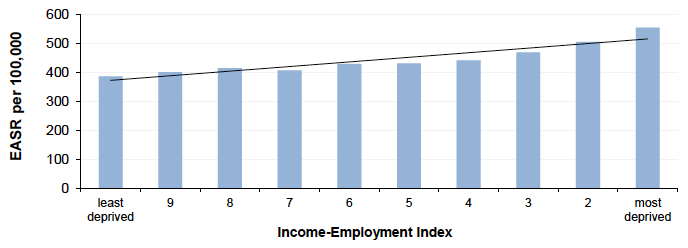
Cancer incidence is more common in the most deprived areas of Scotland. However, this is not the case for all types of cancer. [2] This is driven in part by variations in screening uptake, leading to socially patterned rises in cancer incidence and, in turn, cancer survival for some types of cancer in the least deprived areas.
As has been the case previously, of the most common types of cancer, the absolute gap between most and least deprived areas was largest for cancer of the trachea, bronchus and lung (2014 rates were 141.4 and 28.7 per 100,000 population in the most and least deprived areas respectively).
Trends in relative inequalities
Changes in the relative index of inequality over time have been minimal and show no clear pattern, fluctuating between 0.29 and 0.40.
Figure 7.2: Relative Index of Inequality (RII): Cancer incidence <75y Scotland 1996-2014
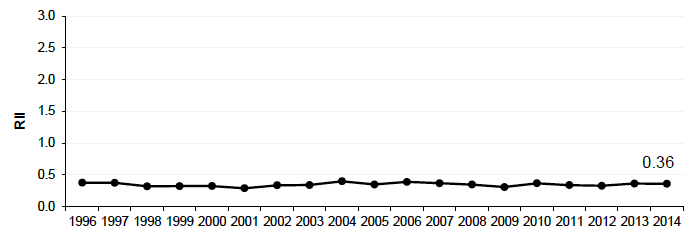
Incidence rates have typically been 30-50% higher in the most deprived areas in Scotland compared to the least deprived (43% in 2014).
Trends in absolute inequalities
Absolute inequality levels in cancer incidence have fluctuated over time. Rates in both the least and most deprived areas of Scotland have shown no clear pattern.
Figure 7.3: Absolute Gap: Cancer incidence <75y, Scotland 1996-2014 (European Age-Standardised Rates per 100,000)
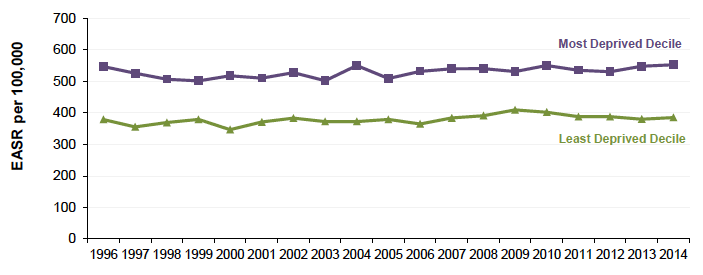
The gap was widest in 2004 (rates of 551.1 per 100,000 and 372.9 per 100,000 in the most and least deprived areas, respectively) but narrowed to its lowest level the following year (rates of 509.5 per 100,000 and 379.6 per 100,000, respectively).
Table 7.1: Trends in cancer incidence (aged < 75), 1997-2015
| Number of new cases | Target population size | Rate per 100,000 ( EASR) | |
|---|---|---|---|
| 1996 | 18,128 | 4,754,906 | 452.7 |
| 1997 | 17,167 | 4,740,269 | 427.4 |
| 1998 | 17,109 | 4,729,975 | 424.3 |
| 1999 | 16,914 | 4,721,298 | 417.5 |
| 2000 | 17,138 | 4,708,667 | 420.6 |
| 2001 | 17,147 | 4,703,661 | 418.9 |
| 2002 | 17,530 | 4,701,958 | 423.6 |
| 2003 | 17,574 | 4,702,431 | 420.8 |
| 2004 | 18,159 | 4,714,233 | 430.3 |
| 2005 | 17,987 | 4,735,320 | 421.9 |
| 2006 | 18,167 | 4,752,425 | 423.3 |
| 2007 | 18,775 | 4,783,452 | 430.8 |
| 2008 | 19,449 | 4,811,453 | 439.7 |
| 2009 | 19,999 | 4,835,007 | 446.6 |
| 2010 | 20,015 | 4,858,058 | 441.9 |
| 2011 | 20,208 | 4,888,316 | 441.3 |
| 2012 | 20,296 | 4,895,114 | 436.8 |
| 2013 | 20,598 | 4,903,074 | 437.7 |
| 2014 | 21,004 | 4,914,362 | 441.1 |
Cancer- deaths aged 45-74 years
Trends in cancer deaths
The cancer mortality rate amongst those aged 45-74 years has fallen by around 26% since 1996 (from 529.8 to 392.9 per 100,000 population, in 2015). The number of deaths each year has also reduced in this period, from around 8,400 to 7,600.
Inequalities in cancer deaths, 2015
Of people in the 45-74 year age group, those in Scotland's most deprived areas are more than twice as likely to die of cancer than those in the least deprived (627.8 deaths per 100,000 population compared to 259.7 per 100,000 population, in 2015).
Figure 8.1: Cancer mortality amongst those aged 45-74y by Income-Employment Index, Scotland 2015 (European Age-Standardised Rates per 100,000)
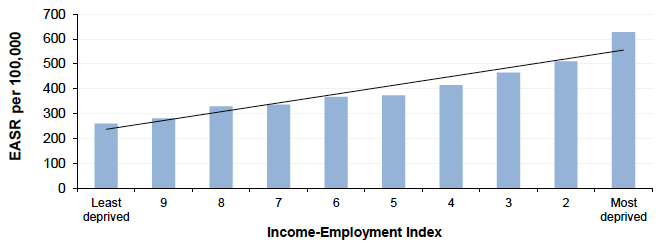
As is the case for cancer incidence, inequality levels vary when examining deaths by cancer type [3] . As described in the previous section, variations in screening uptake may lead to socially patterned rises in cancer incidence and, in turn, cancer survival (therefore having a possible effect on mortality) for some types of cancer.
The most considerable differences between rates in the most and least deprived areas are observed for cancer of the trachea, bronchus and lung (237.4 compared to 52.1 per 100,000 population).
Trends in relative inequalities
Relative inequalities for this indicator have increased over time with the highest value in the time series recorded in 2014 (0.91). The latest RII figure (0.85) compares with a range of 0.68-0.81 seen in the years between 1997 and 2006.
Figure 8.2: Relative Index of Inequality (RII): Cancer mortality 45-74y Scotland 1996-2015
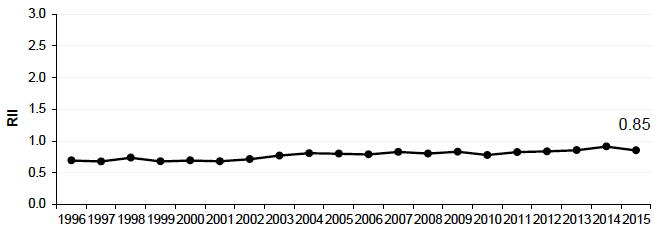
Cancer mortality rates (aged 45-74) were 2.4 times higher in the most deprived compared to least deprived areas in 2015. In 1996, rates were 2.0 times higher in the most deprived areas.
Trends in absolute inequalities
Levels of absolute inequality for cancer deaths have fluctuated since 1997. The gap was narrowest in 2010 when rates were 310.3 per 100,000 in the least deprived areas and 615.1 in the most deprived areas.
Figure 8.3: Absolute Gap: Cancer mortality 45-74y, Scotland 1996-2015 (European Age-Standardised Rates per 100,000)
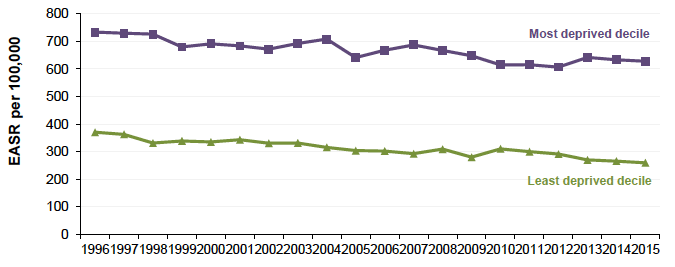
Table 8.1: Trends in cancer mortality (aged 45-74), 1997-2015
| Number of deaths | Target population size | Rate per 100,000 ( EASR) | |
|---|---|---|---|
| 1996 | 8,402 | 1,631,224 | 529.8 |
| 1997 | 8,068 | 1,635,590 | 509.1 |
| 1998 | 7,995 | 1,646,711 | 501.9 |
| 1999 | 7,904 | 1,658,124 | 494.4 |
| 2000 | 7,776 | 1,670,660 | 484.8 |
| 2001 | 7,903 | 1,687,422 | 489.2 |
| 2002 | 7,850 | 1,706,141 | 481.2 |
| 2003 | 7,706 | 1,727,112 | 467.4 |
| 2004 | 7,678 | 1,751,037 | 460.9 |
| 2005 | 7,606 | 1,774,865 | 451.8 |
| 2006 | 7,486 | 1,799,382 | 441.3 |
| 2007 | 7,569 | 1,827,320 | 439.5 |
| 2008 | 7,536 | 1,856,874 | 431.0 |
| 2009 | 7,481 | 1,885,693 | 421.2 |
| 2010 | 7,394 | 1,914,226 | 411.1 |
| 2011 | 7,428 | 1,941,253 | 408.5 |
| 2012 | 7,514 | 1,964,203 | 406.2 |
| 2013 | 7,520 | 1,986,202 | 399.8 |
| 2014 | 7,445 | 2,007,988 | 389.6 |
| 2015 | 7,621 | 2,026,210 | 392.9 |
Alcohol - first hospital admission aged under 75 years
Trends in alcohol-related admissions
The rate of first hospital admissions for alcohol-related conditions amongst those aged under 75 years has fallen over time, with a 26% decrease between 1996 and 2015 (289.8 and 215.3 cases per 100,000 respectively).
Inequalities in alcohol-related admissions, 2015
First alcohol-related admissions are almost 5 times more common in the most deprived areas of Scotland compared to the least (442.2 compared to 90.0 cases per 100,000).
Figure 9.1: Alcohol related hospital admissions amongst those aged <75y by Income-Employment Index, Scotland 2015 (European Age-Standardised Rates per 100,000)
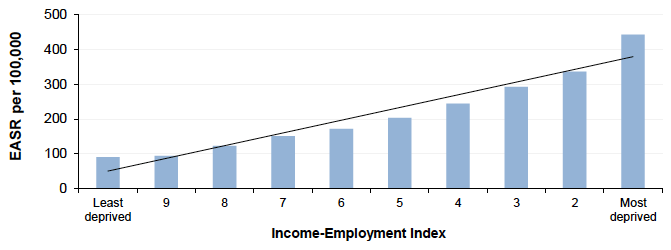
Trends in relative inequalities
A general downward trend was observed in relative inequalities for first alcohol-related admissions between 1997 and 2008 ( RII declining from 1.90 to 1.70). Since then, there has been very little change in the RII figure (1.69 in 2015).
Figure 9.2: Relative Index of Inequality (RII): Alcohol related hospital admissions <75y Scotland 1996-2015
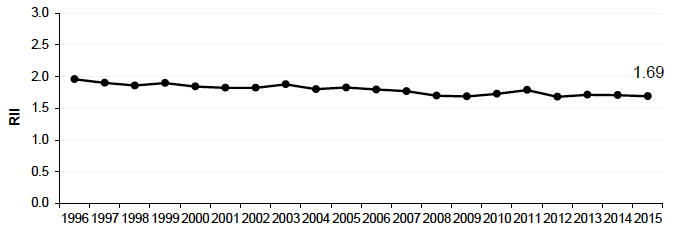
In 1997, first alcohol-related admission rates were seven times higher in the most deprived areas compared to the least deprived. For the last seven years, rates have been around five times higher in the most deprived areas compared to the least deprived.
Trends in absolute inequalities
Absolute inequality in first alcohol-related admissions has generally reduced over time, and is currently the lowest it has been in the time series.
The reduction over the long term in both relative and absolute inequality is largely due to the fall in admissions in the most deprived areas.
Figure 9.3: Absolute Gap: Alcohol related hospital admissions <75y Scotland 1996-2015 (European Age-Standardised Rates per 100,000)
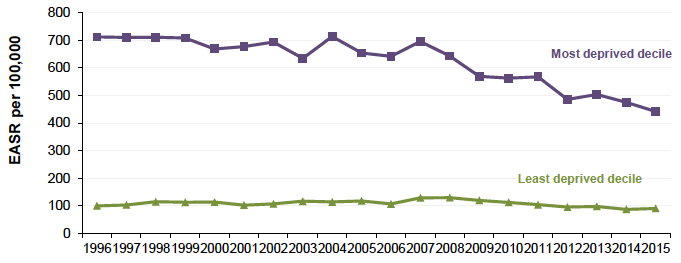
Table 9.1: Trends in alcohol-related hospital admissions (aged < 75), 1997-2015
| Number of admissions | Target population size | Rate per 100,000 ( EASR) | |
|---|---|---|---|
| 1996 | 12,787 | 4,754,906 | 289.8 |
| 1997 | 12,918 | 4,740,269 | 292.6 |
| 1998 | 13,316 | 4,729,975 | 300.7 |
| 1999 | 13,217 | 4,721,298 | 298.2 |
| 2000 | 12,786 | 4,708,667 | 286.6 |
| 2001 | 13,469 | 4,703,661 | 300.3 |
| 2002 | 13,492 | 4,701,958 | 299.9 |
| 2003 | 12,996 | 4,702,431 | 290.0 |
| 2004 | 14,084 | 4,714,233 | 312.5 |
| 2005 | 13,346 | 4,735,320 | 293.8 |
| 2006 | 13,595 | 4,752,425 | 295.3 |
| 2007 | 14,641 | 4,783,452 | 313.5 |
| 2008 | 14,222 | 4,811,453 | 302.3 |
| 2009 | 12,891 | 4,835,007 | 272.9 |
| 2010 | 12,307 | 4,858,058 | 258.7 |
| 2011 | 12,264 | 4,888,316 | 256.2 |
| 2012 | 11,556 | 4,895,114 | 240.9 |
| 2013 | 11,225 | 4,903,074 | 236.8 |
| 2014 | 10,759 | 4,914,362 | 223.2 |
| 2015 | 10,418 | 4,935,283 | 215.3 |
Alcohol - deaths aged 45-74 years
Trends in alcohol-related deaths
Alcohol-related deaths among those aged 45-74 years fell from a peak of 1,899 in 2006 to a low of 1,435 in 2013. In the past two years, however, alcohol-related deaths have increased again
Inequalities in alcohol-related deaths, 2015
The mortality rate in Scotland's most deprived areas is over five times higher than that observed in the least deprived (204.6 compared to 37.1 per 100,000 population).
Figure 10.1: Alcohol related mortality amongst those aged 45-74y by Income-Employment Index,Scotland 2015 (European Age-Standardised Rates per 100,000)
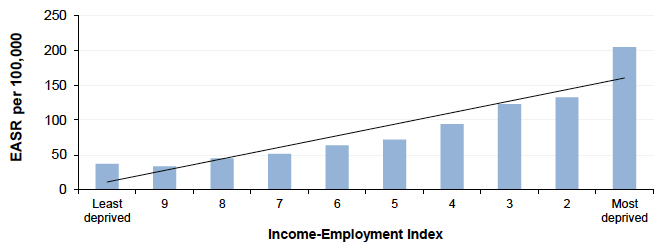
Trends in relative inequalities
Relative inequalities in alcohol related deaths increased between 1997 and 2002 ( RII increasing from 1.88 to 2.23). Following recent fluctuations, relative inequalities are currently the same as they were in 1997 (1.88).
Figure 10.2 : Relative Index of Inequality (RII): Alcohol related mortality 45-74y Scotland 1997-2015
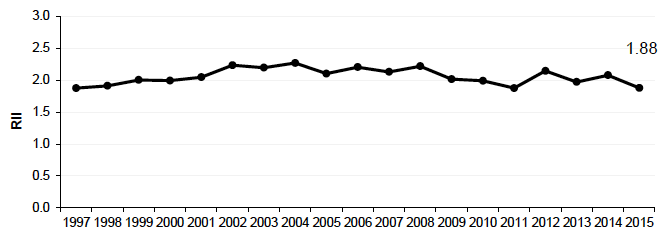
Over time the relative range between the most and least deprived areas has fluctuated, peaking in 2002 when death rates were more than twelve times higher in the most deprived areas. It is currently at the lowest it has been in the times series, with alcohol related death 5.5 times higher in the most deprived areas compared to the least deprived.
Trends in absolute inequalities
Although alcohol-related deaths in the least deprived areas have remained reasonably static since 1997, there has been considerable fluctuation in deaths in the most deprived areas.
Following notable highs in 2002 and 2006, and a recent low in 2013, the 2015 alcohol related mortality rate in the most deprived areas is currently similar to that seen in 1998.
Figure 10.3: Absolute Gap: Alcohol related mortality 45-74y Scotland 1997-2015 (European Age-Standardised Rates per 100,000)
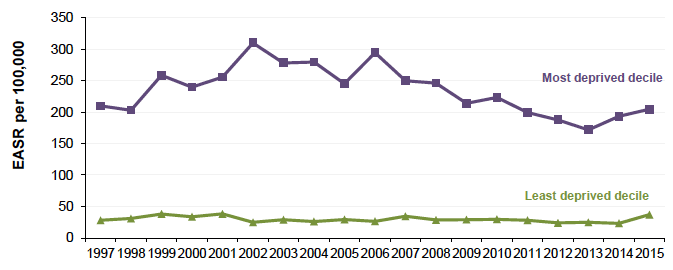
Table 10.1: Trends in alcohol-related deaths (aged 45-74), 1997-2013
| Number of deaths | Target population size | Rate per 100,000 ( EASR) | |
|---|---|---|---|
| 1997 | 1,318 | 1,635,590 | 81.1 |
| 1998 | 1,415 | 1,646,711 | 86.4 |
| 1999 | 1,508 | 1,658,124 | 91.5 |
| 2000 | 1,489 | 1,670,660 | 89.8 |
| 2001 | 1,565 | 1,687,422 | 93.5 |
| 2002 | 1,753 | 1,706,141 | 103.5 |
| 2003 | 1,749 | 1,727,112 | 102.1 |
| 2004 | 1,764 | 1,751,037 | 101.5 |
| 2005 | 1,790 | 1,774,865 | 101.6 |
| 2006 | 1,899 | 1,799,382 | 106.7 |
| 2007 | 1,801 | 1,827,320 | 99.5 |
| 2008 | 1,782 | 1,856,874 | 97.0 |
| 2009 | 1,611 | 1,885,693 | 86.4 |
| 2010 | 1,674 | 1,914,226 | 88.5 |
| 2011 | 1,571 | 1,941,253 | 82.4 |
| 2012 | 1,441 | 1,964,203 | 74.3 |
| 2013 | 1,435 | 1,986,202 | 73.0 |
| 2014 | 1,510 | 2,007,988 | 76.0 |
| 2015 | 1,665 | 2,026,210 | 83.2 |
All-cause mortality aged 15-44 years
Trends in all-cause mortality aged 15-44
Despite an increase in the last year, the mortality rate of those aged 15-44 has reduced from 118.3 per 100,000 in 2006 to 101.2 per 100,000 in 2015. Between 1997 and 2005, the mortality rate ranged between 109.3 and 122.0 per 100,000.
There were a total of 1,976 deaths of people aged 15-44 in Scotland in 2015, compared to the high point of 2,482 in 2006. The 1,976 deaths in 2013 included 306 probable suicides, 442 drug-related deaths and 28 deaths from assault.
While the rates of probable suicide and deaths from assault in this age group have declined in recent years (reaching their lowest levels in 2015 and 2014 respectively), drug-related death have increased since 1997. In 2015, the drug-related death rate was 22.8 per 100,000, this compares with only 8.9 per 100,000 in 1997.
Inequalities in all-cause mortality aged 15-44, 2015
The mortality rate amongst people aged 15-44 years is over five times higher in the most deprived areas (225.2 per 100,000) compared to the least deprived (40.7 per 100,000).
Figure 11.1: Mortality amongst those aged 15-44 years by Income-Employment Index, Scotland 2015 (European Age-Standardised Rates per 100,000)
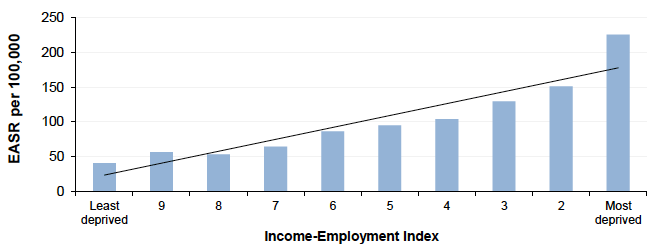
Trends in relative inequalities
There was a gradual increase in relative inequalities between 1997 and 2002. Any trend since then has been less clear, although the three highest datapoints in the time series have all occurred in the last five years.
Since 1999, death rates have typically been between five and six times higher in the most deprived areas compared to the least deprived.
Figure 11.2: Relative index of inequality (RII): mortality aged 15-44y Scotland 1997-2015
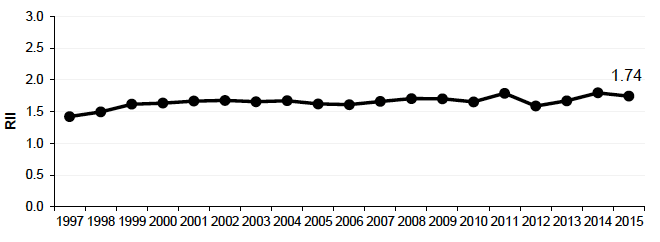
Trends in absolute inequalities
The absolute gap between the most and least deprived areas in all-cause mortality between ages 15 and 44 reached its lowest level in 2013, with death rates of 199.7 and 40.1 per 100,000 respectively (a gap of 159.6 per 100,000).
In the two years since 2013, the mortality rate between ages 15 and 44 in the most deprived areas has increased and the gap between the most and least deprived areas has widened to 184.5 per 100,000.
Figure 11.3: Absolute Gap: Mortality 15-44y, Scotland 1997-2015 (European Age-Standardised Rates per 100,000)
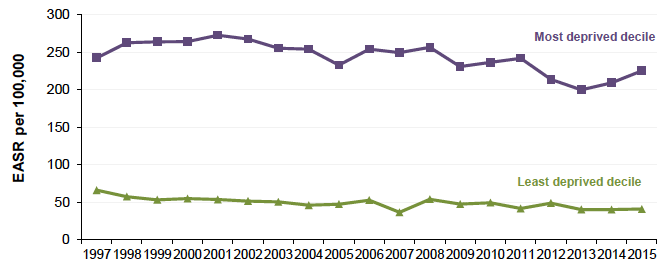
Table 11.1: Trends in all-cause mortality (aged 15-44), 1997-2015
| Number of all-causes deaths | Target population size | Rate per 100,000 ( EASR) | |
|---|---|---|---|
| 1997 | 2,440 | 2,158,030 | 116.3 |
| 1998 | 2,507 | 2,142,787 | 119.4 |
| 1999 | 2,507 | 2,129,794 | 119.0 |
| 2000 | 2,501 | 2,118,568 | 118.7 |
| 2001 | 2,509 | 2,111,242 | 119.0 |
| 2002 | 2,566 | 2,102,670 | 122.0 |
| 2003 | 2,461 | 2,094,408 | 116.9 |
| 2004 | 2,409 | 2,088,563 | 114.7 |
| 2005 | 2,305 | 2,091,415 | 109.3 |
| 2006 | 2,482 | 2,091,581 | 118.3 |
| 2007 | 2,461 | 2,097,902 | 117.5 |
| 2008 | 2,443 | 2,096,495 | 117.5 |
| 2009 | 2,389 | 2,092,065 | 115.1 |
| 2010 | 2,229 | 2,087,635 | 108.6 |
| 2011 | 2,262 | 2,092,311 | 110.8 |
| 2012 | 2,071 | 2,077,902 | 102.8 |
| 2013 | 1,990 | 2,064,867 | 100.1 |
| 2014 | 1,904 | 2,053,897 | 96.8 |
| 2015 | 1,976 | 2,053,401 | 101.2 |
Table 11.2: Trends in deaths from assault, drug-related deaths and probable suicides, 1997-2015
| Deaths from assault | Drug related deaths | Suicides | ||||
|---|---|---|---|---|---|---|
| Number | EASR per 100,000 | Number | EASR per 100,000 | Number | EASR per 100,000 | |
| 1997 | 56 | 2.6 | 196 | 8.9 | 518 | 23.9 |
| 1998 | 65 | 3.0 | 227 | 10.6 | 526 | 24.4 |
| 1999 | 86 | 4.0 | 274 | 12.9 | 529 | 24.7 |
| 2000 | 60 | 2.9 | 268 | 12.7 | 541 | 25.6 |
| 2001 | 63 | 3.0 | 289 | 13.8 | 531 | 25.3 |
| 2002 | 76 | 3.6 | 345 | 16.7 | 539 | 25.7 |
| 2003 | 71 | 3.4 | 282 | 13.6 | 456 | 21.8 |
| 2004 | 78 | 3.8 | 311 | 15.2 | 475 | 22.7 |
| 2005 | 50 | 2.4 | 277 | 13.4 | 436 | 21.0 |
| 2006 | 83 | 4.0 | 350 | 17.1 | 435 | 20.9 |
| 2007 | 54 | 2.6 | 392 | 19.1 | 453 | 21.8 |
| 2008 | 53 | 2.5 | 477 | 23.3 | 480 | 23.4 |
| 2009 | 47 | 2.3 | 436 | 21.3 | 432 | 20.8 |
| 2010 | 54 | 2.6 | 384 | 18.9 | 423 | 20.5 |
| 2011 | 53 | 2.6 | 454 | 22.5 | 420 | 20.5 |
| 2012 | 37 | 1.9 | 416 | 20.8 | 375 | 18.3 |
| 2013 | 35 | 1.7 | 354 | 17.9 | 356 | 17.7 |
| 2014 | 22 | 1.0 | 416 | 21.1 | 309 | 15.4 |
| 2015 | 28 | 1.4 | 442 | 22.8 | 306 | 15.3 |
Low Birthweight
Trends in low birthweight
Around 2,800 low birthweight babies were born in Scotland in 2015.
The percentage of babies born with low birthweight has ranged between 5.0% and 5.3% in the years since 2009. Between 1996 and 2008, the percentage varied between 5.5% and 6.0%.
Inequalities in low birthweight 2015
In 2015, 7.6% of live singleton births in the most deprived areas were recorded as low birthweight. This is more than double the percentage in the least deprived areas (3.7%).
Figure 12.1: Relative index of inequality (RII): Low birthweight babies in Scotland 1996-2015
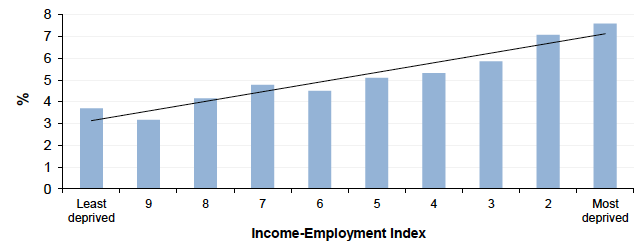
Trends in relative inequalities
Relative inequalities in low birthweight are similar in 2015 to those observed at the start of the time series (0.88 and 0.84 respectively). In the intervening years the RII has ranged between 0.76 and 1.06 with little clear trend.
Figure 12.2: Absolute Gap: Low birthweight babies in Scotland 1996-2015 (as percentage of live singleton births)
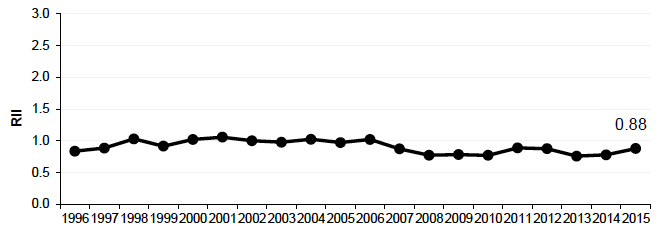
Trends in absolute inequalities
Overall, the absolute gap between the most and deprived areas has reduced from its widest point in 2004 (5.7 percentage points). However, the gap has increased in both of the last two years and currently stands at 3.9 percentage points.
The narrowing and widening of the gap has tended to be driven by changes in the most deprived decile, as the least deprived decile has remained broadly stable since the beginning of the time series.
Figure 12.3: Absolute Gap: Low birthweight babies in Scotland 1996-2015 (as percentage of live singleton births)
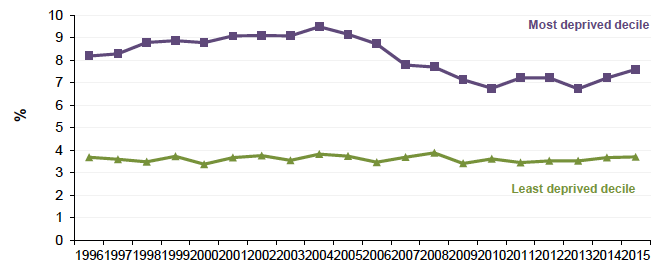
Table 12.1: Trends in low birthweight, 1996-2015
| Number of low birthweight babies | Target population size | % of live singleton births | |
|---|---|---|---|
| 1996 | 3,066 | 55,861 | 5.5 |
| 1997 | 3,149 | 56,982 | 5.5 |
| 1998 | 3,108 | 55,152 | 5.6 |
| 1999 | 3,098 | 52,726 | 5.9 |
| 2000 | 2,906 | 51,057 | 5.7 |
| 2001 | 2,848 | 49,744 | 5.7 |
| 2002 | 2,910 | 48,950 | 5.9 |
| 2003 | 3,026 | 50,069 | 6.0 |
| 2004 | 3,030 | 51,807 | 5.8 |
| 2005 | 3,058 | 51,436 | 5.9 |
| 2006 | 2,939 | 52,467 | 5.6 |
| 2007 | 3,095 | 55,271 | 5.6 |
| 2008 | 3,134 | 56,925 | 5.5 |
| 2009 | 2,893 | 56,107 | 5.2 |
| 2010 | 2,816 | 56,123 | 5.0 |
| 2011 | 2,946 | 56,037 | 5.3 |
| 2012 | 2,775 | 55,369 | 5.0 |
| 2013 | 2,684 | 53,219 | 5.0 |
| 2014 | 2,748 | 54,087 | 5.1 |
| 2015 | 2,814 | 52,766 | 5.3 |
Healthy birthweight
Trends in healthy birthweight babies
In 2015, 90% of babies were of healthy birthweight (of appropriate weight for their gestational age).
In each year of the time series, either 89% or 90% of babies have been of healthy birthweight.
Inequalities in healthy birthweight babies 2015
In 2015, there was a slightly higher percentage of cases of healthy birthweight in the least deprived areas compared to the most deprived areas (90.5% versus 89.8%)
Figure 13.1: Babies with appropriate weight for gestational age in Scotland by Income-Employment index 2015 (as percentage of live singleton births)
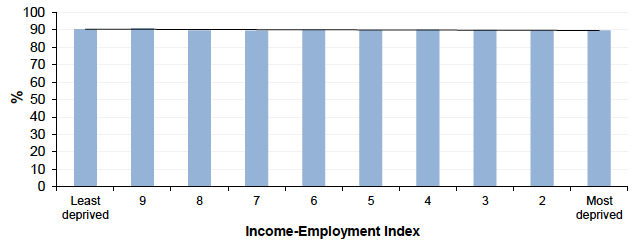
Trends in relative inequalities
Relative inequalities have been consistently low over the times series with the RII for 2015 standing at 0.01.
Figure 13.2: Relative index of inequality (RII): Babies with appropriate age for gestational age in Scotland 1996-2015
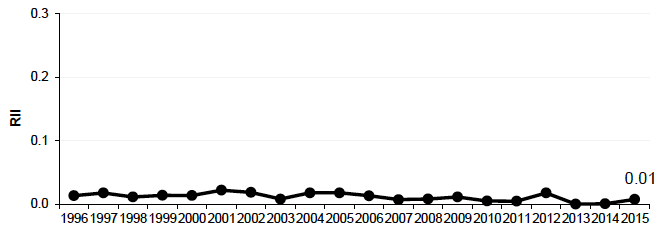
Trends in absolute inequalities
The absolute gap between the percentage of healthy birthweight babies in the most and least deprived deciles has been consistently low across the full time series.
Figure 13.3: Absolute Gap: Babies with appropriate weight for gestational age in Scotland 1996-2015 (as percentage of live singleton births)
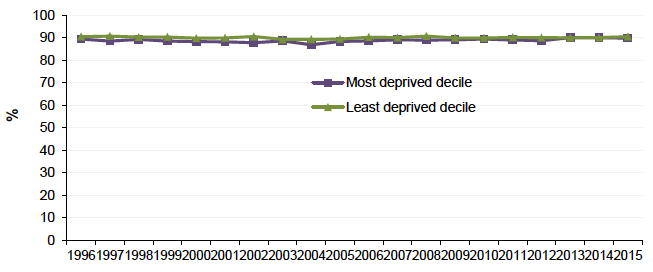
Table 13.1: Trends in healthy birthweight, 1996-2015
| Number appropriate for gestational age | Target population size | % of live singleton births | |
|---|---|---|---|
| 1996 | 49,989 | 55,759 | 89.7 |
| 1997 | 51,113 | 56,895 | 89.8 |
| 1998 | 49,303 | 55,075 | 89.5 |
| 1999 | 47,048 | 52,655 | 89.4 |
| 2000 | 45,292 | 50,978 | 88.8 |
| 2001 | 44,355 | 49,666 | 89.3 |
| 2002 | 43,571 | 48,853 | 89.2 |
| 2003 | 44,539 | 49,956 | 89.2 |
| 2004 | 45,842 | 51,694 | 88.7 |
| 2005 | 45,592 | 51,303 | 88.9 |
| 2006 | 46,678 | 52,330 | 89.2 |
| 2007 | 49,059 | 55,080 | 89.1 |
| 2008 | 50,658 | 56,733 | 89.3 |
| 2009 | 49,880 | 55,907 | 89.2 |
| 2010 | 50,236 | 56,027 | 89.7 |
| 2011 | 49,997 | 55,958 | 89.3 |
| 2012 | 49,454 | 55,249 | 89.5 |
| 2013 | 47,650 | 53,032 | 89.9 |
| 2014 | 48,390 | 53,737 | 90.0 |
| 2015 | 47,222 | 52,452 | 90.0 |
Self-assessed health
Trends in self-assessed health (adults aged 16+)
In 2014/2015 8.2% of adults rated their health as 'bad' or 'very bad'. This is a statistically significant increase from the equivalent percentage in 2008/2009 (7.1%).
Inequalities in self-assessed health 2014/2015
Looking at both equivalised income deciles and IEI deciles there were clear inequalities in self-assessed health.
In 2014/2015, adults in the most deprived areas were around twelve times more likely to report poor health than those in the least deprived areas ( 21.1% versus 1.8%).
Figure 14.1: Proportion of adults (16+ ) rating their general health as bad/very bad by Income-Employment Index, Scotland 2014/2015
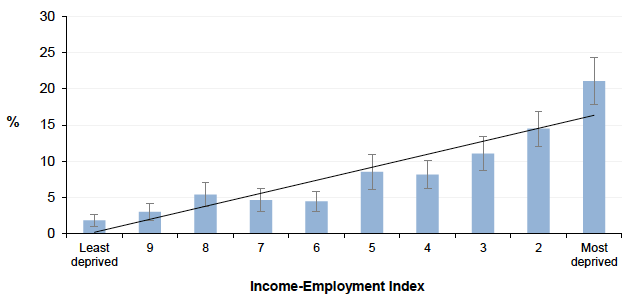
Similarly, adults in the lowest income group were around 8 times more likely to report poor health than those with the highest income (21.1% versus 2.5%).
Figure 14.2: Proportion of adults (16+ ) rating their general health as bad/very bad by equivalised income decile Scotland 2014/2015
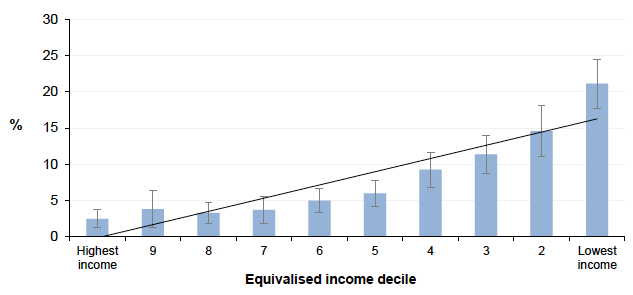
Trends in relative inequalities
When assessed using IEI deciles, relative inequality has increased since 2008/09. In 2014/2015 the IEI RII was 2.17, in 2008/2009 it was 1.87.
In contrast, the 2014/2015 RII calculated using equivalised income deciles (2.30) is similar that observed in 2008/2009 (2.35). The equivalised income RII has generally been higher than that calculated using IEI.
Figure 14.3: Relative Index of Inequality (RII): Proportion of adults (16+ ) rating their general health as bad/very bad Scotland, 2008/2009 - 2014/2015
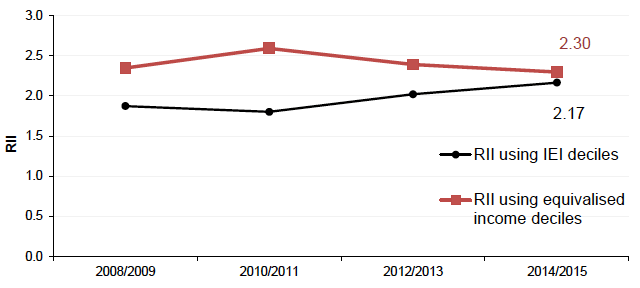
Trends in absolute inequalities
The absolute gap in the percentage of adults reporting poor health has increased between adults with the lowest and highest incomes, as well as between adults living in the most and least deprived areas.
In 2014/2015, the percentage of adults living in the most deprived areas reporting poor health was 19.2 percentage points higher than those in the least deprived areas (21.1% vs 1.8%). This compares with a gap of 13.1 percentage points in 2008/2009.
Figure 14.4: Absolute Gap: Proportion of adults (16+ ) rating their health as bad/very bad Income Employment Index, Scotland, 2008/2009 - 2014/2015
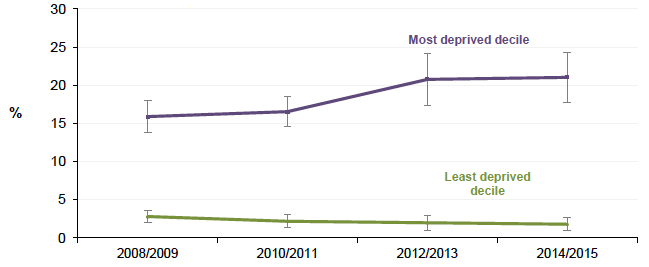
The percentage of adults in the lowest income decile reporting poor health was 18.6 percentage points higher than those in the lowest income decile (21.1% vs 2.5%). This compares with a gap of 14.5 percentage points in 2008/2009.
Figure 14.5: Absolute Gap: Proportion of adults (16+ ) rating their health as bad/very bad Equivalised income decile Scotland, 2008/2009 - 2014/2015
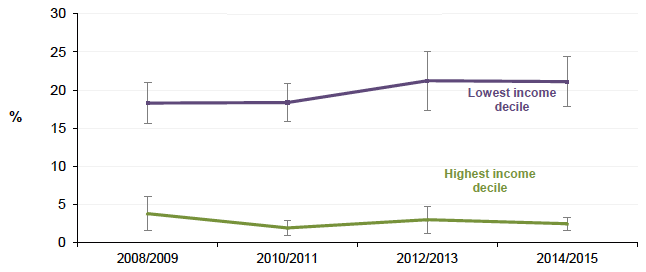
Table 14.1: Trends in self-assessed health, 2008/2009 to 2014/2015
| Year | % of adults rating general health as bad/very bad | Lower 95% confidence limit (%) | Upper 95% confidence limit (%) |
|---|---|---|---|
| 2008/2009 | 7.1 | 6.6 | 7.6 |
| 2010/2011 | 7.6 | 7.0 | 8.1 |
| 2012/2013 | 8.6 | 7.9 | 9.4 |
| 2014/2015 | 8.2 | 7.5 | 8.9 |
Limiting long-term conditions
Trends in limiting long-term conditions (adults aged 16+)
A limiting long term condition is defined as a physical or mental health condition or illness lasting 12 months or more that reduces an individual's ability to carry-out day-to-day activities.
The percentage of adults reporting a limiting long term condition has increased from 26% in 2008/2009 to 32% in 2015/2016.
Inequalities in limiting long-term conditions 2014/2015
In 2014/2015 there were similar levels of inequalities observed between IEI deciles as between equivalised income deciles.
In 2014/2015, adults in the most deprived areas were 2.4 times more likely to report a limiting long term condition than those in the least deprived areas ( 48.7% versus 20.0%).
Figure 15.1: Proportion of adults (16+ ) with a limiting long-term condition by Income-Employment Index, Scotland 2014/2015
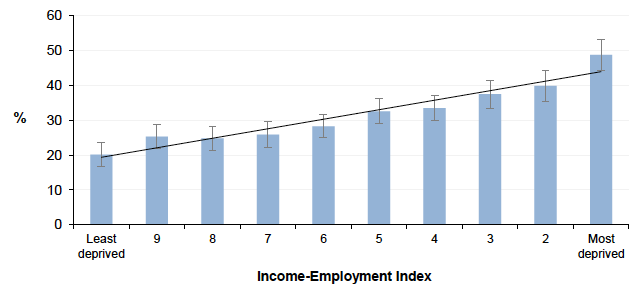
Adults in the lowest income decile were 2.6 times more likely to report a limiting long term condition than those in the highest income decile (52.7% versus 20.2%).
Figure 15.2: Proportion of adults (16+ ) with a limiting long-term condition by equivalised income decile, Scotland 2014/2015
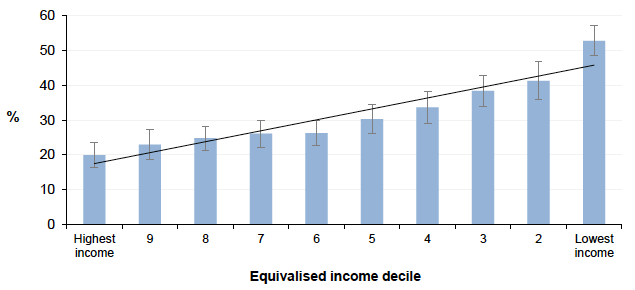
Trends in relative inequalities
When assessed using IEI deciles, relative inequality has been steady since 2008/2009 (ranging between 0.83 and 0.87).
RII calculated using equivalised income deciles has generally been a little higher over the same period and has shown more change. The RII for 2014/2015 was 0.99, the lowest in the time series.
Figure 15.3: Relative Index of Inequality (RII): Proportion of adults (16+ ) with a limiting long-term condition Scotland, 2008/2009 - 2014/2015
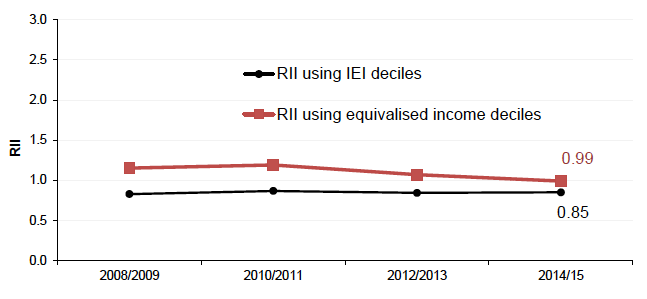
Trends in absolute inequalities
The absolute gap in the prevalence of limiting long term conditions between the most and least deprived areas has increased over the time series. In 2008/2009 the gap was 20.5 percentage points, by 2014/2015 this had increased to 28.6 percentage points.
Figure 15.4: Absolute Gap: Proportion of adults (16+ ) with a limiting long-term condition Income Employment Index decile Scotland, 2008/2009 - 2014/2015
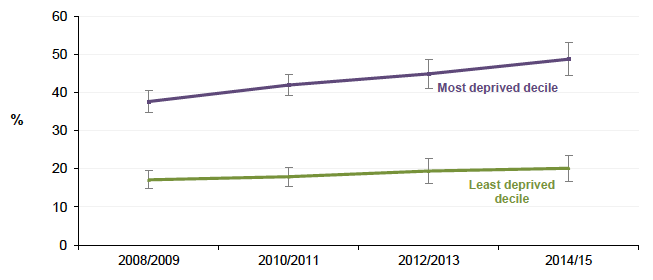
There has also been an increase in the gap between the highest and lowest income deciles. In 2008/2009 prevalence of limiting long-term conditions was 25.0 percentage points higher amongst the lowest income decile, in 2014/2015 the gap was 32.8 percentage points.
Figure 15.5: Absolute Gap: Proportion of adults (16+ ) with a limiting long term condition Equivalised income decile Scotland, 2008/2009 - 2014/2015
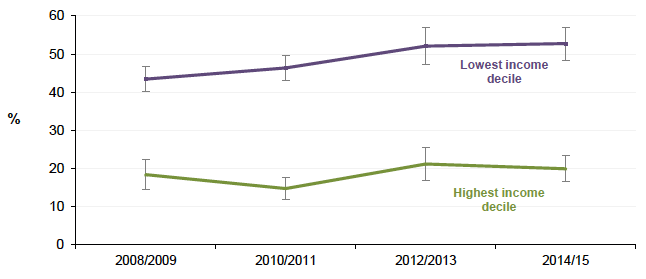
Table 15.1: trends in limiting long-term conditions, 2008/2009 to 2014/2015
| Year | % reporting limiting long-term condition | Lower 95% confidence limit | Upper 95% confidence limit |
|---|---|---|---|
| 2008/2009 | 25.6 | 24.7 | 26.6 |
| 2010/2011 | 28.1 | 27.1 | 29.0 |
| 2012/2013 | 31.6 | 30.2 | 33.0 |
| 2014/2015 | 31.7 | 30.5 | 33.0 |
Contact
Email: Andrew Paterson
There is a problem
Thanks for your feedback